If you’re new to the world of sleeping bags, let us offer an introduction: There are a ton of options to choose from, and they all vary widely in terms of materials, design, weight, cost, and functionality. That means finding the right one for you requires clarity around your intended use for the bag, the weather you’ll be facing, your budget, and some other factors.
If you’re in need of a highly technical bag (say, for mountaineering or rugged backpacking), then head to an outfitter that specializes in outdoor gear. But if you’re looking for a bag to keep you cozy on a beginner backpacking trip, while car camping, or while sleeping under the stars in your backyard, then you’ve come to the right place. This roundup should offer an array of options to suit every entry-level to intermediate camper’s needs.
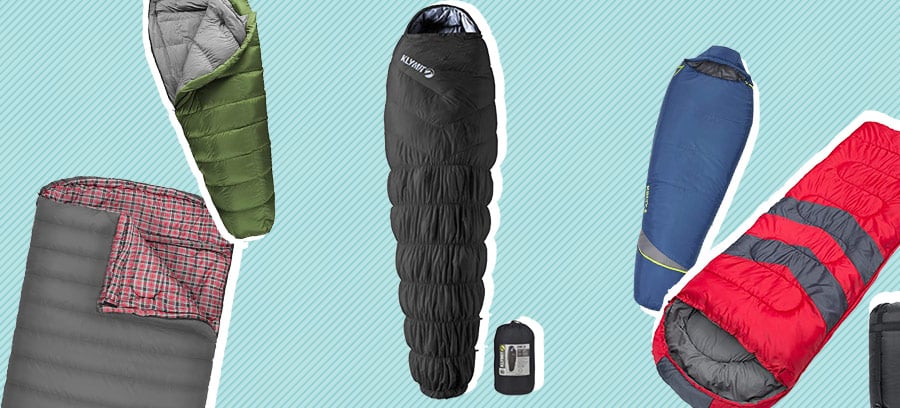
Best for Backpacking
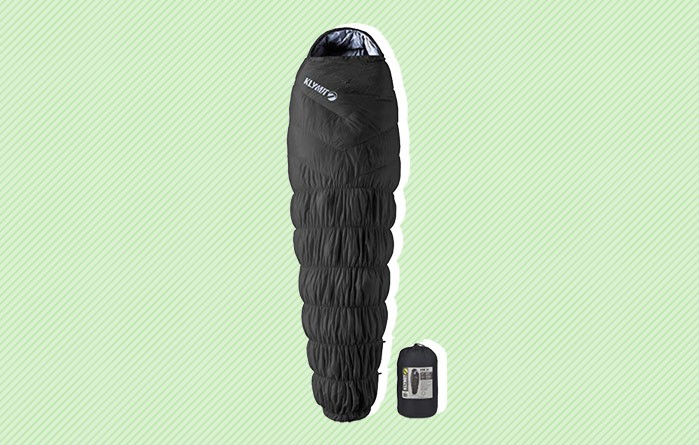
KLYMIT KSB 20 Down Sleeping Bag
Pros:
- The bag weighs just 2.75 pounds and packs down well, so it won’t take up tons of space or add a lot of weight to a backpack.
- The draft collar, over-stuffed footbox, and insulated hood help protect against heat loss. The bag is rated at 20 degrees F, so it should provide three-season comfort.
- The broadened chest area and flex baffles make it easier to change positions and sleep comfortably compared to other mummy bags.
- Adjustable Length Locks let you reduce the bag’s length by up to 15 inches, which helps you narrow in on the right length for you (and cuts down on heat loss).
Cons:
- While the bag’s lining is water-resistant, it’s not waterproof. And the filling is real duck down, which gets heavy when wet and takes a while to dry. This could be an issue if you find yourself in the backcountry with a wet bag.
- Many users have reported that the bag tends to “leak” feathers.
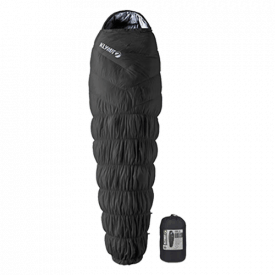
At well under 3 pounds, the KLYMIT KSB 20 Down Sleeping Bag provides you with overnight comfort without breaking your back during daytime treks. The bag is designed for three-season warmth.
Backpacking Contender
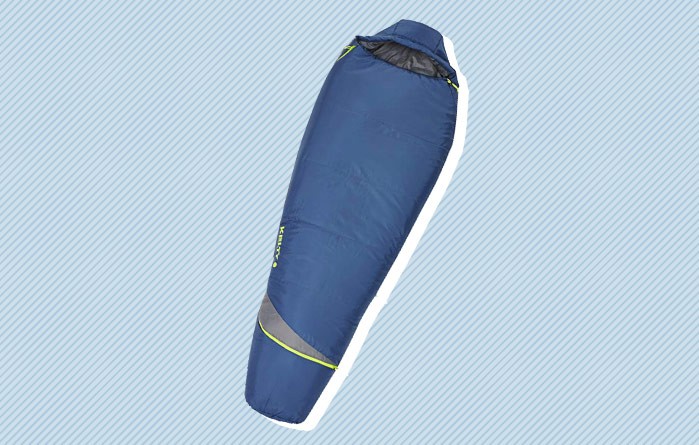
Kelty Tuck 22F Degree Mummy Sleeping Bag
Pros:
- The mummy hood, footbox, and draft tube work together to help retain heat. The bag is rated to 22 degrees Fahrenheit.
- The synthetic down bag compresses to a small cubic volume, so you can easily squeeze it into a pack.
- The footbox’s Comfort Tuck design gives you the option of poking one or both feet out of the bag, which can help keep you comfortable on warmer nights.
- An integrated stash pocket provides a safe place to store a phone or small valuables.
Cons:
- At 3 pounds, this isn’t an ultralight bag. But it’s still light enough for backpacking, especially if you load the rest of your backpack with weight in mind.
- Broad-shouldered or taller people might find the shoulder area to be a bit narrow, which could feel restrictive and make it harder to sleep comfortably.
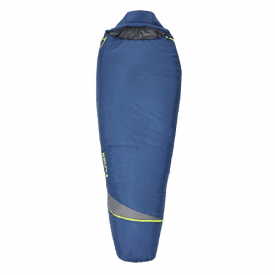
Enjoy cold- and warm-weather comfort in the Kelty Tuck 22F Degree Mummy Sleeping Bag, which features a unique footbox design that lets you poke your feet out on hot nights. The bag compresses easily and takes up little space in a backpack.
Best for Cold Weather
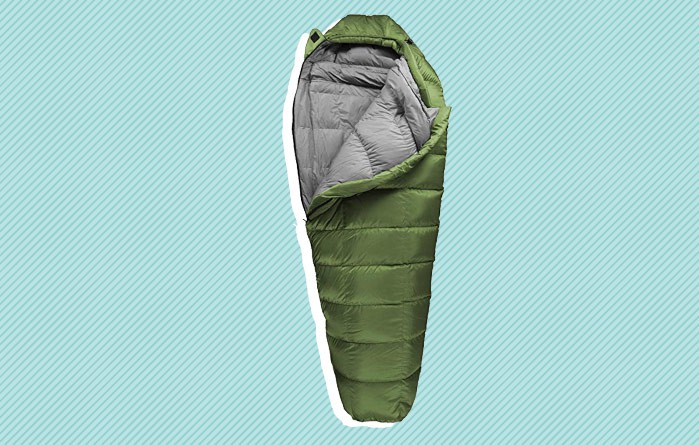
Outdoor Vitals Summit Down Sleeping Bag
Pros:
- The bag is stuffed with 800 fill power down and tested to remain warm to approximately 0 degrees Fahrenheit. Extra down around the feet helps keep your toes toasty.
- The outer shell is made from rip-stop fabric and coated with a water-resistant substance to help protect against condensation
- At just under 3 pounds, this bag is lightweight and easy to transport.
- The bag compresses well for easy packing and a minimal storage footprint.
Cons:
- The zipper may be prone to snagging, which can be a pain when you’re trying to regulate temperature in the middle of the night. The drawstrings for the draft collar and hood also tend to snag.
- While the outer lining is water-resistant, it’s not waterproof. Real down gets heavy when wet and takes a while to dry, so it will be important to keep the bag dry.
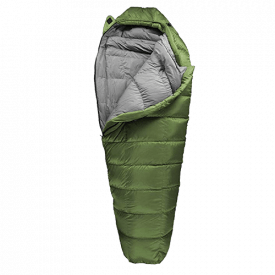
Enjoy cold-weather comfort in the Outdoor Vitals Summit Down Sleeping Bag, which boasts 800 fill power down and is rated to around 0 degrees Fahrenheit. A rip-stop, water-resistant shell helps protect against camping snafus.
Cold Weather Contender
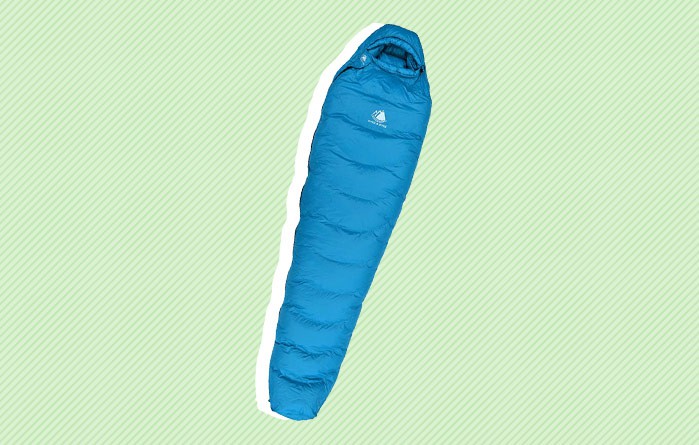
Hyke & Byke Snowmass Hydrophobic Down Sleeping Bag
Pros:
- The bag is stuffed with 650 fill power duck down and rated to 0 degrees Fahrenheit, so it should keep you toasty even on cold nights.
- The construction utilizes a variety of water-repellent and waterproof fabrics to ensure you sleep dry.
- YKK zippers and an anti-snag slider help protect against the zipper snags that are common with sleeping bags.
- The brand conducts third-party testing and offers a lifetime warranty.
Cons:
- While the brand calls this bag ultralight, it’s 3.75 pounds — which is significantly heavier than many other bags. This shouldn’t be an issue unless you’re wanting to use the bag for backpacking.
- Some users have noted that the bag can produce an unpleasant smell when it first arrives.
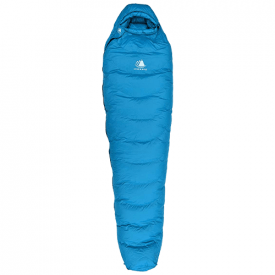
The Hyke & Byke Snowmass Hydrophobic Down Sleeping Bag features 650 fill power duck down to keep you warm in cold temps. A unique anti-snag zipper makes temperature regulation a breeze.
Best for Warm Weather
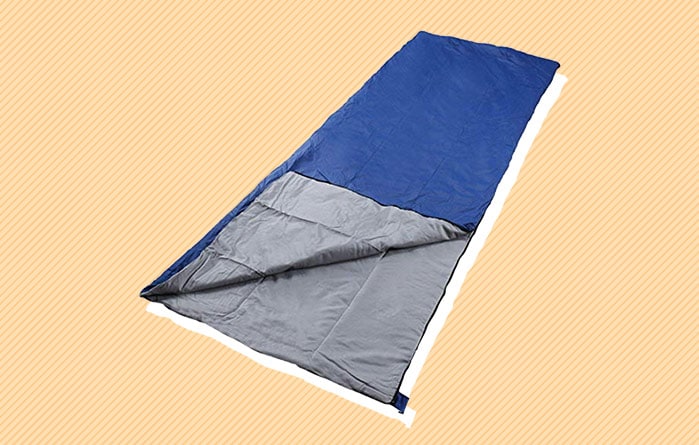
ECOOPRO Warm Weather Sleeping Bag
Pros:
- At less than $35, this bag is seriously budget-friendly.
- The bag weighs less than 2 pounds and compresses very well, which makes it lightweight and portable.
- The manufacturer says the bag is waterproof and ideal for temps around 50 degrees Fahrenheit and up, so it should sleep comfortably in warm weather. The bag is not suitable for colder temps, but it doesn’t claim to be.
Cons:
- The bag isn’t made from especially high-quality materials and is very thin, so it doesn’t offer much cushion and might not hold up over the long term.
- The bag is fairly compact and might not be large enough to accommodate tall, large, or broad-shouldered people.
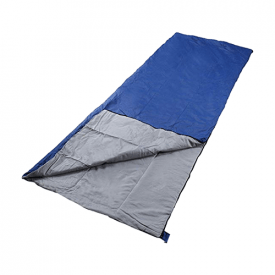
Sleep cool and dry in warm-weather temps in the ECOOPRO Warm Weather Sleeping Bag, which features a low price and an even lower weight. At less than 2 pounds, the bag is incredibly easy to compress and transport.
Warm Weather Contender
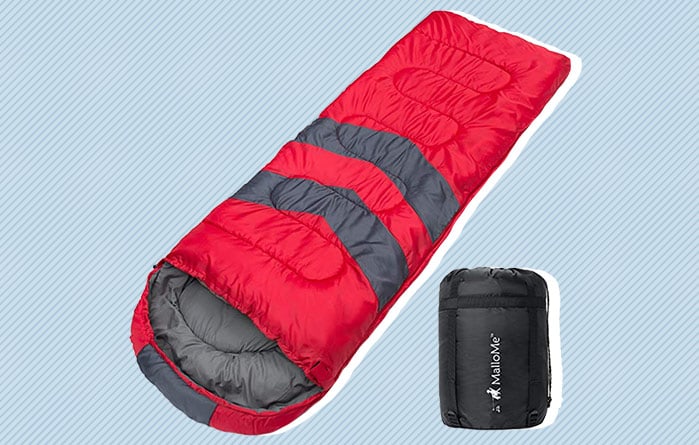
MalloMe Camping Sleeping Bag
Pros:
- The bag can be cleaned with a wet cloth or machine washed, which makes it easy to clean up after camp trips or sleepovers.
- The double-layer bag features a waterproof shell to help keep you comfortable on wet nights.
- The bag has a drawstring at the top and an adjustable opening at the feet, which helps you stay cool in warmer weather.
- The bag is wider than many other options, which means it can accommodate broader-shouldered people.
Cons:
- At 4.5 pounds, this is a fairly hefty bag and is not suitable for backpacking.
- This bag costs around $50, which is budget-friendly — but it also means the bag is made from lower quality materials. The zippers are prone to snagging and may not hold up to long term use, and the stitching may not last.
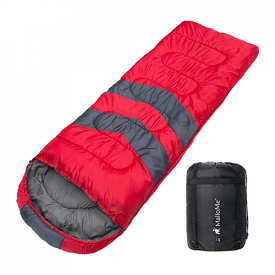
An adjustable top and bottom make the MalloMe Camping Sleeping Bag comfortable in a variety of warmer temps. The machine washable bag is easy to care for.
Best Couples Bag
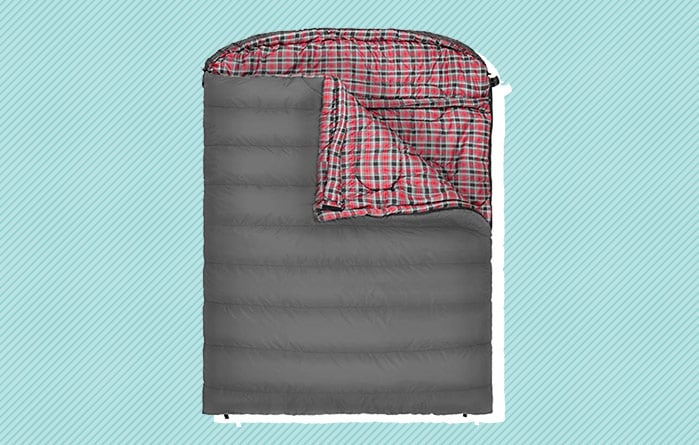
TETON Sports Mammoth Queen-size Double Sleeping Bag
Pros:
- As the name suggests, this “mammoth” bag is truly massive. At 94 inches long and 62 inches wide, the bag is longer and wider than a standard queen-sized mattress. Two people (or more) should be able to sleep comfortably in this bag.
- You can choose from multiple temperature ratings. One option is rated to 20 degrees Fahrenheit, while the other is rated to 0 degrees. A mummy hood and draft tubes help retain heat on both options.
- The soft inner lining promotes snuggly comfort.
- Two-way zippers are designed to work easily with minimal snagging.
Cons:
- At a hefty 14-plus pounds, this bag takes up a lot of storage space, is difficult to pack down, and takes some effort to transport. Definitely not suitable for backpacking!
- The bag’s materials aren’t the highest quality, and it may not stand up to years of use.
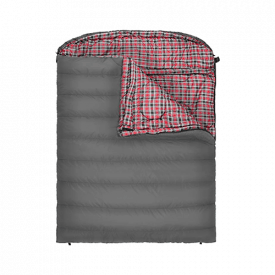
Cuddle up with your partner or kiddos in the enormous TETON Sports Mammoth Queen-size Double Sleeping Bag, which can accommodate two people and then some. Choose from two temperature ratings depending on your intended camping locale.
How We Picked
The world of sleeping bags includes everything from basic bags hastily purchased for a Girl Scouts campout to highly technical gear designed to keep adventurers alive in the most extreme weather conditions. We’re more focused on the “Scouts” side of that spectrum (though you will find some semi-technical bags on this list). To help people choose the right entry-level sleeping bag for their needs, we considered the following.
Cost
When you start researching sleeping bags, you’ll notice their cost can range from around $20 to well over $500. “You get what you pay for” almost always holds true: Cheaper bags are more likely to feature lower quality materials and to be less durable, while more expensive bags will probably use higher quality materials and boast greater durability and technical specs.
That said, there’s no reason to spend hundreds of dollars on a bag that you’re going to use for short car camping trips or backyard camping. Your intended use for the bag will help you determine just how much quality and durability actually matter.
Functionality
There are a lot of reasons to use a sleeping bag, and they all require slightly different specs. So we included bags with a range of functions to suit different needs.
Looking to cuddle up with your partner under the stars? Check out the couples options. Snoozing outside in the Florida heat? Look for a warm-weather bag. Heading into the mountains for a campout? Don’t go up there without a cold-weather bag, even in the summer! And if you’re planning to backpack, choose a lightweight bag that won’t weigh you down.
Materials
The materials in a sleeping bag can have a big impact on its function and weather-proofing. For instance, real down is very insulating but gets heavy when wet. Synthetic down options have come a long way and can perform well in a variety of conditions. Some bags come with water-resistant linings, and others don’t. We included an array of materials so you can choose what suits you best.
Weather-proofing
Some bags are optimized for cold temps, while others are only suitable for warmer climes. Some bags feature waterproofing or water-resistance, and others don’t. You’ll want to look for weather-proofing that’s appropriate to where you’re planning to camp. We included a variety of options so you can find what works for you.
And speaking of temperature: Note that the rating for a bag doesn’t guarantee you’ll be comfortable at the number in question; it usually just means the bag will help you keep you alive in those temps. So if a bag is rated to 15 degrees Fahrenheit, you probably won’t be warm at that temp unless you add a liner, a ground pad, some layers, and so on.
Sleepopolis Buying Tips
To find the best sleeping bag for your needs, consider the following:
- Where are you planning to camp? This will tell you whether you need a bag that’s suitable for cold or warm temps (or both). It will also let you know whether you want to prioritize water resistance.
- How will you transport your sleeping bag? If you’re planning to backpack, then it’s essential to look for a lightweight bag (or pay the price while backpacking!). If you’re car camping, then weight won’t matter so much — but it could dictate a size constraint if you’re short on car space.
- Who are you camping with? If you want to cuddle up with a partner or you know your kiddo is liable to crawl into your bag, consider a couples option (or one that’s wider than a standard mummy bag). If you’re going to be squeezed into a backpacking tent beside a friend, then a narrower mummy bag might be most space-efficient.
All the research in the world doesn’t compare to taking a bag into the wild and giving it a try. So consider buying from a brand with a solid return policy so you can test out a bag before committing to it long-term. When you find the right fit, you’ll be sleeping easy.


























